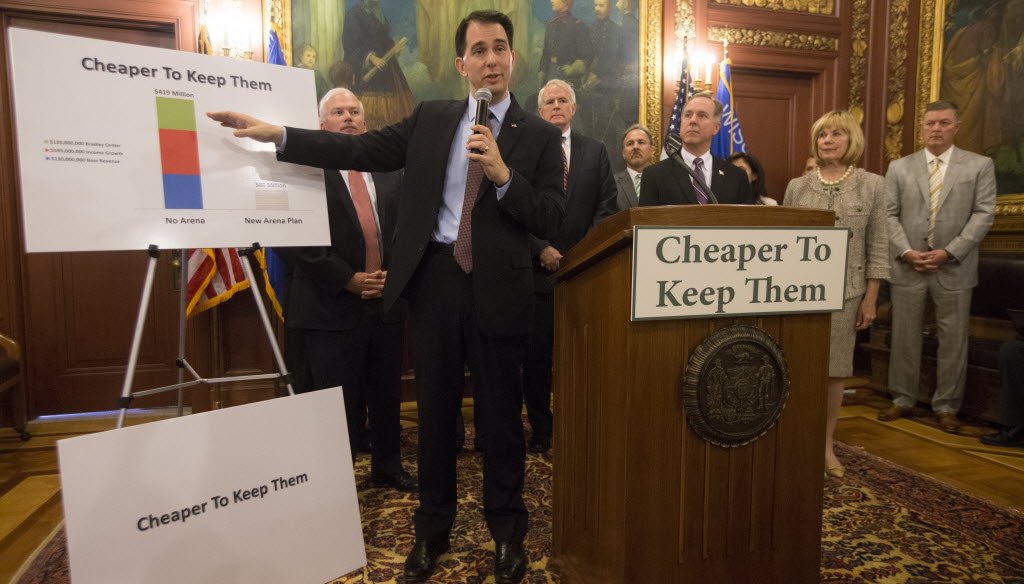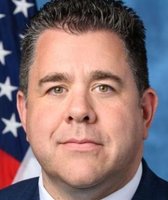Stand up for the facts!
Our only agenda is to publish the truth so you can be an informed participant in democracy.
We need your help.
I would like to contribute

At a Capitol news conference on June 4, 2015, Gov. Scott Walker announced new details of a proposal to build a new arena for the Milwaukee Bucks and a slogan aimed at persuading lawmakers and taxpayers to support the deal.
In announcing more details of a proposal to build a new arena for the Milwaukee Bucks, Gov. Scott Walker unveiled a slogan that's aimed at persuading lawmakers and taxpayers to back the deal.
"Cheaper to keep them," Walker said June 4, 2015 at a Capitol news conference.
The slogan underlines what Walker argues is a key selling point of the plan: That it would cost more to taxpayers if no arena is built and the Bucks left town than what the plan calls for taxpayers to spend on a new facility.
The arena funding proposal -- which comes as Walker pursues a presidential bid and is entangled with negotiations over the state budget -- has the backing of Milwaukee Mayor Tom Barrett and Milwaukee County Executive Chris Abele, but it has been coolly received by Republican state lawmakers.
Several in the Senate have said they will not vote for the plan as it stands, putting its future in doubt.
Sign up for PolitiFact texts
Walker’s "cheaper to keep them" comparison is based on projections that have not yet been vetted by independent groups, such as the Legislative Fiscal Bureau. And the proposal itself has not yet been drafted into bill form for lawmakers to vote on. So we feel it is too early to rate it, or a variation of it, on the Truth-O-Meter.
But based on the preliminary numbers, we’re taking a look at Walker’s equation and the assumptions it is built on.
As we’ll see, there is some basis for Walker’s claim. But it’s premature to declare that it would be cheaper for taxpayers to keep the Bucks, by building a new arena, than it would be if no arena is built and the Bucks left town.
Cost if Bucks stay
The Bucks have played in the BMO Harris Bradley Center since the facility opened in 1988 in what is now the third-oldest arena in the National Basketball Association. Replacing it took on a new urgency in April 2014 when former U.S. Sen. Herb Kohl of Milwaukee announced he was selling the Bucks to billionaire investors Marc Lasry and Wesley Edens.
Under the agreement, if a new arena is not built in time for the 2017-’18 NBA season, the league could buy the team and move it to another city -- which means there is a real risk Milwaukee would lose the Bucks if no arena is built.
The projected cost of a new arena is $500 million, and Kohl and the new owners have committed to contributing a total of $250 million. The other half would be paid by state and local taxpayers.
In making his comparison, Walker has cited the $250 million public contribution -- and sometimes only the $80 million portion to be provided by the state.
But in doing so he is low-balling the starting point.
With interest, the public’s $250 million is expected to eventually total at least $400 million, sources have told the Milwaukee Journal Sentinel.
However, that figure has not been independently established, so in the end it could be higher or lower. But it will clearly be substantially higher than $250 million.
Cost if Bucks go
On the other side of his equation, Walker contends it would cost taxpayers at least $419 million if no arena is built and the Bucks moved out of state.
So, even if the cost to keep them is $400 million, it could still be cheaper -- but only if that $419 million is solid.
Before we examine Walker’s $419 million figure, here are a couple things to keep in mind about the Bradley Center.
-- Although the Bradley Center was built entirely with private money -- a $93 million gift from the late Milwaukee philanthropist Jane Bradley Pettit -- it is a state-chartered facility. In order to receive the donation, state law created a non-profit corporation that runs the facility as an "instrumentality" of the state. And since the state has also given the Bradley Center two $5 million grants in recent years, it has an ownership interest.
-- More than half of the Bradley Center’s revenue reportedly comes from the Bucks. So, if the Bucks leave, the Bradley Center would have a more difficult time meeting its operating and maintenance needs.
Walker’s $419 million figure, which he calculates over 20 years, breaks down into three parts:
1. Current income taxes -- $130 million
According to Walker’s Department of Revenue, the state will collect $6.5 million in income taxes from NBA players for 2014. Multiplying $6.5 million times 20 years yields a total of $130 million.
That seems a solid estimate, given that the NBA’s annual player payroll rarely declines from one year to the next.
2. Growth in income taxes -- $169 million
This figure is also from the Department of Revenue. It anticipates NBA salaries will rise, and with them the amount of state income tax collected.
The annual income tax figure is projected to rise from $6.5 million in 2014 to $7 million in 2015, $7.4 million in 2016 and so on, eventually reaching $25 million in 2034. The total increase over the 20 years is estimated at $169 million.
Player salaries are expected to rise significantly -- at least over the next few years -- as a result of the NBA’s nine-year, $24 billion television contract announced in October 2014. The league’s salary cap, which is $63 million for the 2014-’15 season, is projected to jump to $108 million in the 2017-’18 season.
However, it’s more difficult to project out further what salaries will do, and there have been times -- including as recently as the 2012-’13 season -- when the salary cap didn’t increase.
If the first two parts of Walker’s $419 million figure are correct, losing the Bucks would mean a loss in state income taxes over 20 years of $299 million -- $130 million plus $169 million.
But at least some of that revenue, according to economists and state budget analysts, would be replaced by higher taxes paid by other individuals and businesses.
Sports economist Andrew Zimbalist told us that roughly half of the money that pays the salaries of Bucks players comes from money spent by local Bucks fans.
If the Bucks left Milwaukee, those fans would not simply sit on the money they had been spending at Bucks games -- they would spend much of it locally on other sporting events or other forms of entertainment. And that spending would generate income for other businesses and their employees, which in turn would generate additional income, sales and other tax revenue.
"The actual computation is rather sophisticated," Zimbalist said of trying to gauge how much the state would lose in taxes from NBA players but regain from other taxpayers. "It’s not something that one could know off the top of their head."
At the same time, income taxes from the portion of the Bucks salaries not paid for by local fans -- and the income taxes from visiting players -- would not be so easily replaced, even in part.
3. Bradley Center costs -- $120 million
The final piece of Walker’s $419 million figure is less firm. He says $120 million in Bradley Center expenses and debt would would have to be taken on by the state if the Bucks left.
But that amount has not been verified by an independent source. Moreover, it’s not clear whether the state would be legally responsible for the expenses if the Bucks moved and left the Bradley Center in financial straits.
The governor’s office said the $120 million figure, spread over 10 years, comes from the Bradley Center.
It includes $60 million in projected operating deficits, including those caused by the loss of the Bucks, $30 million in deferred maintenance, $20 million in outstanding debt and a $10 million loss of revenue due to an anticipated loss of events as a result of not being able to afford to make renovations to the facility.
Greg Murray, the top lawyer in Walker’s Department of Administration, said in a memo dated the same day Walker made his announcement "it is highly likely" the state "would become financially responsible" for the arena if the Bucks leave Milwaukee. He argues the Bradley Center wouldn’t receive enough revenue to continue operating or maintaining the facility, and the state would be "the last man standing" and become financially responsible for the facility.
By comparison, the City of Milwaukee and Milwaukee County don’t have such ownership interests in the Bradley Center.
But there are at least two issues with this part of Walker’s claim.
If Milwaukee lost the Bucks, the Bradley Center certainly would take action to try and replace at least some of that revenue by adding other events, such as concerts or shows. Besides being the current home of the Marquette University men’s basketball team and the Milwaukee Admirals American Hockey League team, it has also been home to other sports teams in the past.
Secondly, a memo issued June 9, 2015 by nonpartisan attorneys at the state Legislative Council concluded "it appears unlikely" that the state’s ownership interest in the Bradley Center "would serve as an independent basis for holding the state generally liable for all debts and obligations."
The memo does note, however, that a court could hold the state liable for some expenses or debts.
It should be pointed out that, setting aside the question of legal obligations, there could be significant public pressure for the state -- and perhaps the city and county -- to help the Bradley Center if it were headed toward insolvency. But there is no way of knowing how much money that could entail.
Meanwhile, with Walker having just concluded a trade mission in Canada, Republican leaders in the Legislature are still finalizing the arena plan in order to put it into the form of legislation.
GOP Assembly Speaker Robin Vos said June 16, 2015 of his colleagues: "They all want to see the details."
More on the arena
Go here for the Milwaukee Journal Sentinel’s special section on Milwaukee’s arena debate.
More on Scott Walker
For profiles and stories on Scott Walker and 2016 presidential politics, go to the Milwaukee Journal Sentinel's Scott Walker page.
Our Sources
Milwaukee Journal Sentinel, video of Gov. Scott Walker news conference, June 4, 2015
Email exchange, Gov. Scott Walker press secretary Laurel Patrick, June 4, 2015
Interview, Wisconsin Budget Project researcher Jon Peacock, June 12, 2015
Milwaukee Journal Sentinel, "Interest could push public cost of new Bucks arena over $400 million," June 1, 2015
Milwaukee Journal Sentinel, "Arena construction -- not just plans -- linked to Bucks lease," Sept. 6, 2014
Milwaukee Journal Sentinel, "BMO Harris Bradley Center posts $1.9 million loss for fiscal 2014," Dec. 11, 2014
Milwaukee Journal Sentinel, "The cost of keeping the BMO Harris Bradley Center alive," April 22, 2014
Gov. Scott Walker, news release, June 4, 2015
Wisconsin Legislative Fiscal Bureau, arena memo, March 24, 2015
Wisconsin Legislative Fiscal Bureau, arena memo, Sept. 30, 2014
Wisconsin Legislature, state law creating Bradley Center Sports and Entertainment Corp.
Interview, Public Policy Forum president Rob Henken, June 11, 2015
Interview, Metropolitan Milwaukee Association of Commerce president Tim Sheehy, June 16, 2015
Interview, Wisconsin Taxpayers Alliance president Todd Berry, June 11, 2015
RealGM.com, "NBA salary cap history," accessed June 15, 2015
Public Policy Forum, "Pulling back the curtain: Assessing the needs of major arts, cultural, recreational and entertainment assets in Milwaukee County," December 2013
Interview, Community Advocates Public Policy Institute senior fellow David Riemer, June 11, 2015
Interview, Smith College sports economist Andrew Zimbalist, June 15, 2015
Interview, Holy Cross College sports economist Victor Matheson, June 15, 2015
New York Times, "With TV deals ahead, players reject salary cap limits," March 11, 2015
Email exchange, National Basketball Players Association spokeswoman Tara Greco, June 12, 2015
Grant Thornton, Bradley Center consolidated financial statements, Dec. 1, 2014
State Rep. Dean Knudson, opinion column, June 15, 2015
Wheeler Report, Wisconsin Legislative Council arena memo, June 9, 2015























